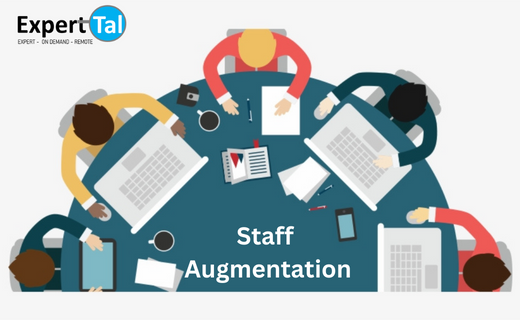-

Staff Augmentation : An Introduction
Staff augmentation is temporarily using outside personnel to augment your organization’s capacity. It is the modern form of the old practice of using contingency workers in case full-time employees are unavailable. Today, hiring external resources in businesses is a rising trend globally. The global staffing industry is predicted to grow in value to above $500 billion by 2028. The IT industry is using staff augmentation to optimize its processes.
When Can You Use Staff Augmentation?
1. You can hire more staff to handle temporary workload spikes, increase demand, and ramp up production when needed.
2. You can hire temporary staff while you build a more permanent team to ensure that work doesn’t stop
3. You can hire skilled IT experts for a time to plug any knowledge gaps you may perceive in your in-house resources.
4. You could structure your organization to work with flexible staff to gain a competitive advantage by reducing costs or time to market.
Staff Augmentation: Pros and Cons
Pros
1. Augmented staff can add value by understanding and completing projects in a time crunch.
2. Organizations can add staff to plug in any skill gaps needed for particular projects instead of hiring new employees.
3. Augmented staff can come in handy during increased demands for the short term.
Cons
1. Not a great solution for projects requiring highly contextual knowledge or sensitive information.
2. Augmented staff may be expensive if the projects run long or if the requirements are ongoing.
3. Increased dependence on third-party companies to find augmented staff.
Types of Staff Augmentation
1. Commodity: It is useful when you need reliable workers to perform tasks that don’t require a specific skill set, such as manual labor or warehouse work.
2. Skill-Based: It is excellent for situations requiring basic skills such as typing, language, clerical work, and data processing.
3. Highly Skilled: The augmented staff has advanced skills requiring years of training and experience, such as marketing, software development, or design work.
Types of Staff Augmentation Services
There are numerous ways you can engage augmented staff, depending on your specific needs. Each approach has its merits and demerits.
1. Traditional Staffing Services: They provide commodity and skill-based temporary labor for non-critical projects that don’t require much skill. It allows organizations to be flexible, but it can be challenging to find highly skilled workers this way. Adecco is an example of such a service.
2. Master Vendor Staffing Services: Vendors run large-scale staffing programs providing commodity labor. This is great for hiring people at low costs, but there might be challenges with quality. Randstad is one of the best providers of such a service.
3. Boutique Staffing & Consulting Firms: Small firms provide highly specialized and skilled staff. You get high-quality experts, but it can be costly with large overheads.
4. Gig Platforms: You can instantly access skilled workers for task-based work. It is excellent if you need to be flexible and quick. It may be difficult to choose between the numerous workers working from around the globe. You might be familiar with Freelancer, Fiverr, and Upwork.
5. On-demand Platforms: These online platforms provide access to curated, highly-skilled talent that can be deployed quickly. You can find talent from across the globe to work as per your needs. ExpertTal and TopTal are the market leaders in this space.
Staff Augmentation: Mythbusting
There are some common myths employers have about using staff augmentation.
Some hiring managers believe they can circumvent the cost of paying benefits for a full-time employee by hiring augmented staff instead. The benefit costs get factored into the rate quoted to an organization. This misunderstanding can lead to spending more out of pocket for augmented staff when full-time employment would have been a more suitable solution.
Staff augmentation is not as expensive as employers think. There are additional costs to hiring a full-time employee. The expenses include matching, 401k, insurance, and other benefits, which account for 20-30% extra over the salary. Hiring augmented staff is more cost-effective in various situations.
A managed service approach concerns a final deliverable, possibly with a definitive quality rating; staff augmentation involves a job description and is paid for on a time and material basis. An augmented staff member might be brought into an organization to write lines of code for a specific application unusual for that company and would be paid per hour. A managed service contractor would be hired to create that particular application and meet a set of KPIs; they would be paid upon project completion.
Follow us on LinkedInAbout the Author

Kamal Rastogi is a serial IT entrepreneur with 25 yrs plus experience. Currently his focus area is Data Science business, ERP Consulting, IT Staffing and Experttal.com (Fastest growing US based platform to hire verified / Risk Compliant Expert IT resources from talent rich countries like India, Romania, Philippines etc...directly). His firms service clients like KPMG, Deloitte, EnY, Samsung, Wipro, NCR Corporation etc in India and USA.